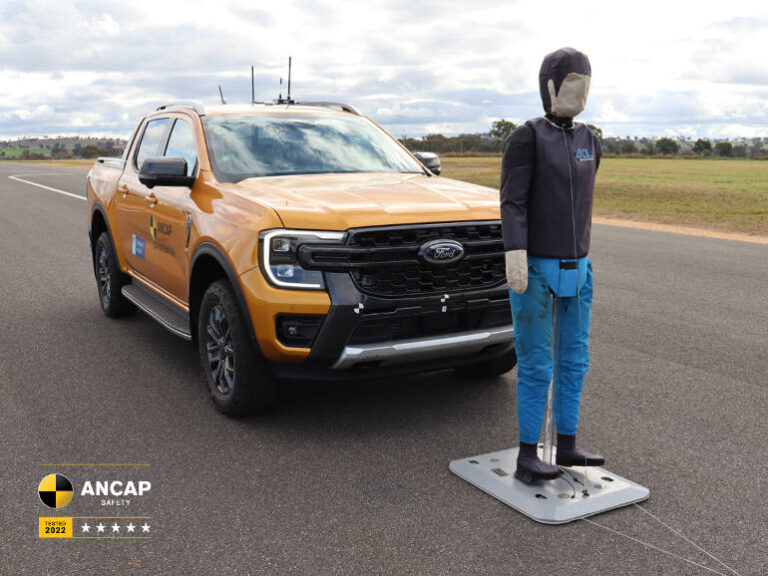When writing a fleet policy it’s easy to skip through the procurement section by stating that every vehicle must have a five star ANCAP rating. While this is a good way to ensure all new vehicles added to the fleet will have a minimum level of safety, five star ANCAP ratings depend on the year a vehicle was tested. So with the benchmark being raised in 2023, is it time to review your fleet policy?
The ANCAP ratings have continually evolved since the body was established in 1992 and in 2015 they started the transition to introduce Euro NCAP data into the ratings system. In 2018 common test protocols were developed for Australia and Europe which added more criteria to achieve the coveted five star rating.
Further testing changes were implemented in 2020 and in 2023 the bar has been lifted even higher. The change was so significant that several manufacturers had older vehicles retested (with updates since their initial launch) in 2022 so they could maintain a five star rating under the old regime.
One example of the 2023 changes is the requirement for doors and windows to operate when a car is underwater. ANCAP will assess whether car doors are able to be opened without battery power and electric windows remain functional and able to be opened, for up to two minutes after submergence.
With stricter criteria in 2023, there’s a chance some popular fleet models being released in 2023 may not receive a five star ANCAP rating. They may have more active and passive safety technology than the model they replace, or similar models already on sale, but without the official five star rating, your policy may exclude them as an option for your fleet.
ANCAP’s advice to car buyers is, “Our best advice is to look for a model with a five-star ANCAP safety rating and the latest “TESTED” date stamp you can afford.”
This statement would normally refer to second hand cars, though to achieve the higher benchmark car manufacturers will need to add more sensors, more cameras, and more microchips which will increase the price of base model cars that are popular with fleet buyers.
ANCAP changes
Click here to see what’s new with ANCAP in 2023.
ANCAP assess four areas to determine the star rating for new vehicles:
- Adult Occupant Protection
- Child Occupant Protection
- Vulnerable Road User Protection
- Safety Assist
The main area of change in 2023 is Vulnerable Road User Protection which is explained as:
Assesses the design of the front of the vehicle to minimise injury risk to a struck pedestrian. Vehicles are also assessed for their ability to actively avoid or mitigate impacts with pedestrians, cyclists, and powered two wheelers.
Vehicles might achieve five stars for the other three areas but not achieve the five star rating overall because they do not score well on the additional criteria required in 2023 which are:
- Head impact (cyclist)
- AEB (motorcycle)
- LSS (motorcycle)
Click here to see the breakdown of the scores required in each area.
Choosing the safest (and cheapest) vehicle
ANCAP provides a great tool for fleet buyers on their website called – Help me choose. You can select the vehicle category and price range to display the five star rated vehicles suitable for your fleet.
I searched for a medium SUV under $35,000. The only option was the GWM Haval H6. When I adjusted the filters, it has not been tested under the 2023 criteria. If my fleet budget allowed me to spend over $35,000, there were only four options that achieved a five star ANCAP rating under the 2020 rules and none that have been tested in 2023.
The popular RAV4 was tested in 2019 and achieved a five star rating before the ANCAP changes in 2020. Star ratings expire after six years which means an updated RAV4 will need to be crashed using the 2023 standards before December 2025.
A number of popular vehicles (Toyota Prado, Mitsubishi Triton, Mazda CX-3, Nissan Navara) lost their ANCAP rating at the end of the 2022 and currently remain unrated.
Updating your fleet policy
Fleet Policies aren’t fixed documents. Fleet Managers should review them regularly, or when there’s a significant event that impacts the ability to adhere to the policy.
The 2023 changes to the ANCAP testing criteria is a significant step in making vehicles safer for all road users, but it will make it harder, and more expensive, to stick with an existing fleet procurement policy that mandates five stars.
One option is allow four star ratings. Another option is to accept different ratings in the four areas of the ANCAP assessment. For example, the Adult/Child Occupant Safety and Safety Assist must be five stars, but the Venerable Road User Protection is acceptable at four stars.
Whatever the solution for your fleet, a review of the policy in the next six months will ensure it stays relevant in a changing market.






